PARK(ing) DAY + a green Gov. Hogan?
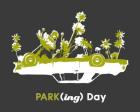
Back in September, PARK(ing) DAY was enacted worldwide. It was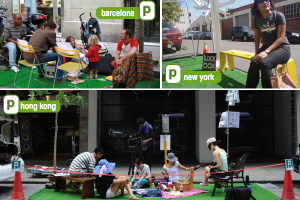 begun in 2005 by a San Francisco art and design studio, Rebar. It converted a single metered parking space into a temporary public park in the downtown.
begun in 2005 by a San Francisco art and design studio, Rebar. It converted a single metered parking space into a temporary public park in the downtown.
There have been memorable PARK(ing) DAYS in Baltimore. One was organized a couple of years ago by the Reservoir Hill Improvement Council. Teachers’ parking spaces at John Eager Howard Elementary School were turned into a “composting kitchen” where, according to a Baltimore Sun report, students learned how to build real and edible compost boxes.
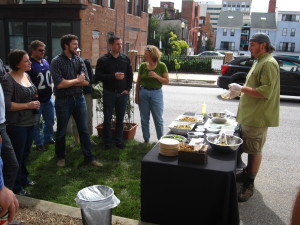 In 2009, Floura Teeter, a well-established landscape architecture firm in Baltimore, hosted its 3rd annual celebration in W. Franklin St. parking spaces which it converted into a cooking demonstration place. Noted at its website: “Undeterred by the traffic whizzing by in the background, Chef Tom Campbell of sustainable caterer Patchwork Catering presented a cooking demonstration using seasonal ingredients provided by Real Food Farms. Chef Tom prepared three delectable dishes: a yummy raw Swiss chard salad, a grilled zucchini Caponata salad and a Mediterranean lentil salad that elevated the little beans to new heights of culinary deliciousness.”
In 2009, Floura Teeter, a well-established landscape architecture firm in Baltimore, hosted its 3rd annual celebration in W. Franklin St. parking spaces which it converted into a cooking demonstration place. Noted at its website: “Undeterred by the traffic whizzing by in the background, Chef Tom Campbell of sustainable caterer Patchwork Catering presented a cooking demonstration using seasonal ingredients provided by Real Food Farms. Chef Tom prepared three delectable dishes: a yummy raw Swiss chard salad, a grilled zucchini Caponata salad and a Mediterranean lentil salad that elevated the little beans to new heights of culinary deliciousness.”
A temporary French Bistro, near the corner of N. Charles and W. Chase Streets, was its theme this year where: “Visitors stopped by to sit and enjoy their lunch from the nearby food trucks and relax for an extended lunch break in true French fashion.”
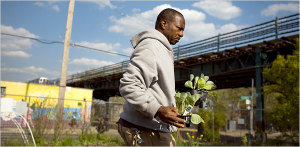 While PARK(ing) DAY draws attention to our car-centric culture, a kind of un-parking/lot event is increasingly occurring in U.S. cities and elsewhere. This event is centered on tearing up asphalted surfaces for permeable ones.
While PARK(ing) DAY draws attention to our car-centric culture, a kind of un-parking/lot event is increasingly occurring in U.S. cities and elsewhere. This event is centered on tearing up asphalted surfaces for permeable ones.
In cooperation with the Chesapeake Bay Trust and the U.S. EPA, Baltimore City recently announced the 7 winners of the 2014 Growing Green Design Competition: Vacant Lots Transformed. This competition is an earnest attempt to address the horrible stormwater runoff problem out-falling into the Inner Harbor and the Chesapeake Bay beyond. (I blogged about a solar water wheel skimmer that’s moored at the foot of the Jones Falls outfall at the Inner Harbor to collect as much as 25 tons/day of stormwater-borne refuse.)
According to Civic Works, one of the winners, projects were formulated according to The Green Pattern Book—the Growing Green Initiative tool used to guide the greening of vacant land. The booklet, produced by the Baltimore Office of Sustainability, showcases 8 different project types for stabilizing and re-using vacant land while reducing stormwater runoff and providing community enhancements.
Civic Works’ project will turn a Baltimore City vacant lot into a pocket park. Beneficial Inner Harbor/Bay effects will include decreased stormwater runoff and increased filtration for water contaminants. Of course impervious surfacing will be removed. One of its partners is Floura Teeter Landscape Architects.
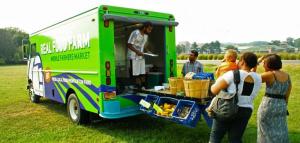 Another winner is Real Food Farm which operates from Clifton Park and also offers a mobile farmers market that provides food to “Baltimore food deserts.” From the news release about its $63K project: “‘Flower Factory at Broadway East’ employs community-minded design principles to integrate stormwater management and a new brand of urban agriculture – cut flower production. The Flower Factory will provide passerby[sic] with a welcoming introduction to the neighborhood for residents and visitors alike to enjoy the neighborhood sights.”
Another winner is Real Food Farm which operates from Clifton Park and also offers a mobile farmers market that provides food to “Baltimore food deserts.” From the news release about its $63K project: “‘Flower Factory at Broadway East’ employs community-minded design principles to integrate stormwater management and a new brand of urban agriculture – cut flower production. The Flower Factory will provide passerby[sic] with a welcoming introduction to the neighborhood for residents and visitors alike to enjoy the neighborhood sights.”
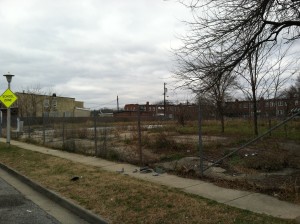 Perhaps the most ambitious of these is the Chesapeake Bay Foundation’s scope for a 30,000 sq. ft. vacant lot in the Bridgeview/Greenlawn community. From its application: “Besides providing water holding and treatment capability, the native landscaping will provide beneficial habitat for urban wildlife including pollinator species, butterflies, and birds.” Its stormwater management calcs indicate that “by removing approximately 90% of the impervious surface on site, a 79% reduction (almost 242,000 gallon reduction) in annual runoff volume will occur.” A promised rain garden: “will allow for community volunteer involvement in their planting along with other site re-vegetation opportunities. With full implementation, [CBF anticipates] greater than 1,000 square feet of rain garden area.” One of its partners in the project is Biohabitats, Inc., of Baltimore.
Perhaps the most ambitious of these is the Chesapeake Bay Foundation’s scope for a 30,000 sq. ft. vacant lot in the Bridgeview/Greenlawn community. From its application: “Besides providing water holding and treatment capability, the native landscaping will provide beneficial habitat for urban wildlife including pollinator species, butterflies, and birds.” Its stormwater management calcs indicate that “by removing approximately 90% of the impervious surface on site, a 79% reduction (almost 242,000 gallon reduction) in annual runoff volume will occur.” A promised rain garden: “will allow for community volunteer involvement in their planting along with other site re-vegetation opportunities. With full implementation, [CBF anticipates] greater than 1,000 square feet of rain garden area.” One of its partners in the project is Biohabitats, Inc., of Baltimore.
In Sundry Department – “Hogan’s chance to be a green governor”
In an opinion piece last weekend, Baltimore Sun columnist Dan Rodricks suggested that Governor-elect Larry Hogan has a chance to recognize a big environmental problem threatening the Bay rather than threaten environmentalists for the benefit of agriculture-as-usual. A $75M project that Gov. O’Malley never got off the ground was a 10-MW biomass plant on the Eastern Shore which would recycle chicken manure into electric power rather than further fertilize/saturate chicken farm land with the stuff that’s killing the Bay. This project was actually funded as a part of the 2011 Excelon-Constellation Energy merger. Chicken king Purdue has formed Perdue BioEnergy LLC to invest equity in biofuel plants. A nice one could be built just down the street from its HQ in Salisbury. Whatever. Governor-elect: Get on it! $$ are there!
